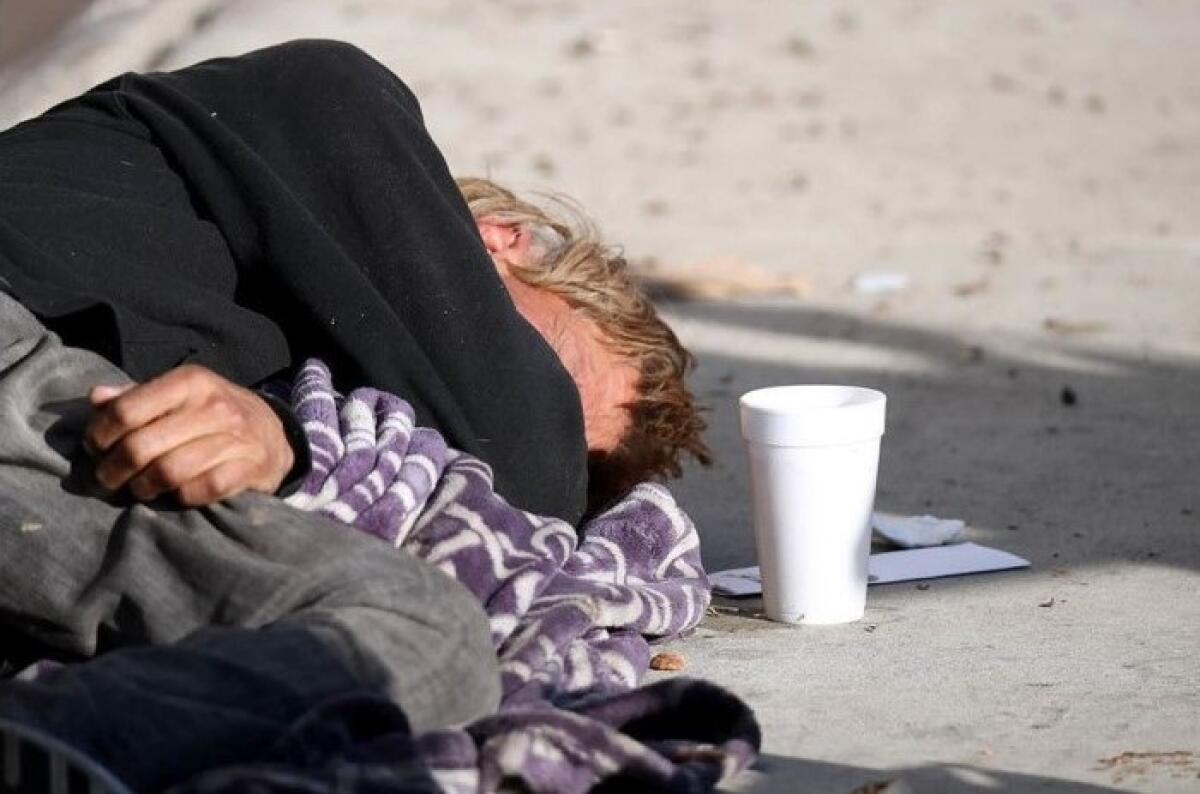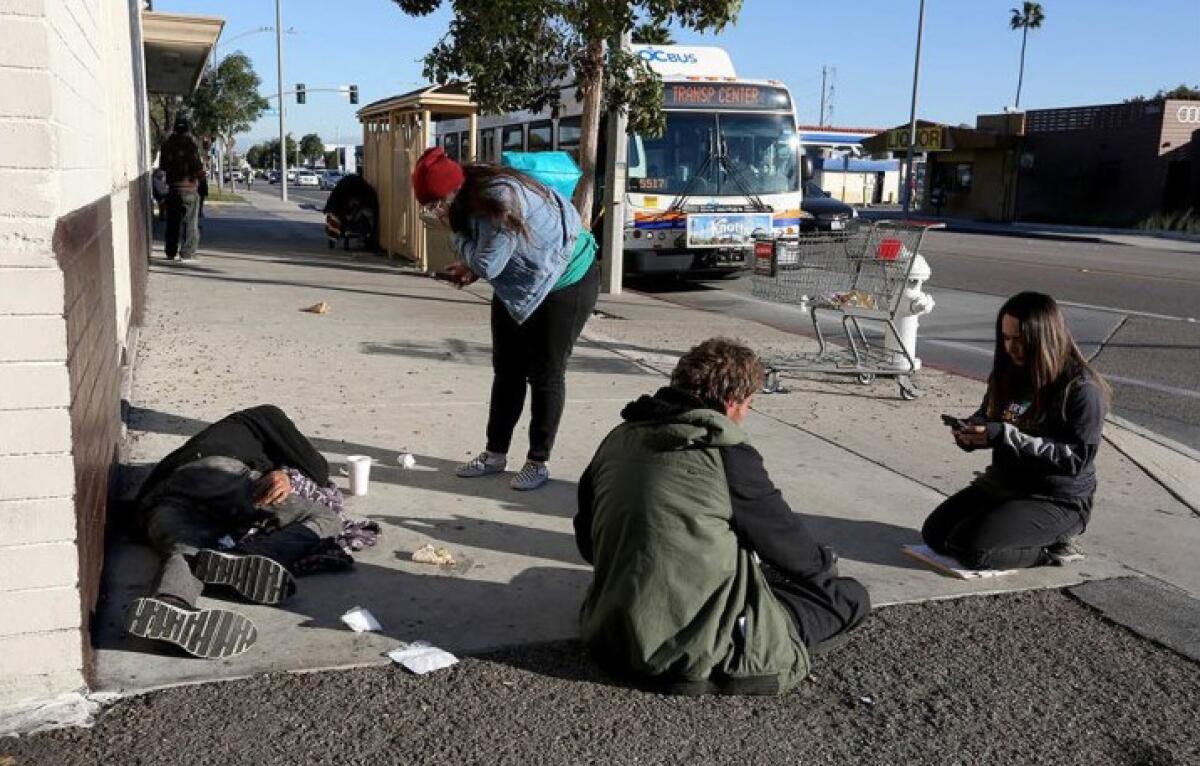‘People are going to die:’ Santa Ana revokes permit of business that helps homeless and drug users

- Share via
For the second year in a row, more homeless people died in Orange County in 2021 than any other year. Many of those deaths were due to drug overdoses, with many of them involving the powerful synthetic drug fentanyl.
Carol Newark, a clinical operations director for a drug addiction clinic in Santa Ana, said that one of the best methods to counteract overdoses is naloxone, a lifesaving opioid reversal drug. Newark said her clinic, the Harm Reduction Institute at the American Addiction Institute of Mind and Medicine in Santa Ana, has distributed more than 34,000 doses of naloxone, which has saved about 3,059 people since it opened in 2019.
But the institute had to shut down last week after the city revoked its occupancy permit, claiming that it violated zoning code by operating as a counseling service rather than a medical office. The institute has been based out of an office at 1533 E. 4th St. since 2019, when it was co-founded by Dr. Faried Banimahd and Mahan Naeim, a UC Irvine medical student.
Jeremy Tolchin, an attorney representing the institute, sent a letter to the city on Friday appealing the decision. City spokesman Paul Eakins said the institute can’t be in the building while the appeal hearing is pending.
Newark said that the institute has been shut down since last Wednesday after receiving the city’s notice. The institute is working remotely now, but they are having a difficult time maintaining services. In addition to distributing naloxone, the institute also provides counseling, clean syringes and wound care — essential resources for Santa Ana’s large homeless population, the institute’s leaders contend.
“They gave us absolutely no time to wind down at all,” Newark said. “It just cut everything off immediately, which seems very extreme.”
Eakins said over the phone that there has been an ongoing discussion with the institute about this issue, so it wasn’t “a surprise to them.”
The city first notified the institute that it planned to revoke the occupancy permit in November. In mid-December, a short administrative hearing was held. It was overseen by Minh Thai, executive director of the city’s planning and building agency, who made the decision to revoke the permit.
The institute, which has more than 1,400 clients, provided walk-in case management and walk-in naloxone distribution. Clients could also walk in to the institute to receive help with any number of issues, including figuring out health insurance problems and troubleshooting housing issues.
“All of that has had to completely stop because we don’t have a place for people to come,” Newark said.
With about 70% of their clients being homeless, Newark said it’s difficult to provide counseling over Zoom because people need an internet connection. The institute has also had to stop its harm reduction walk-in clinic on Mondays, which allows for people to access new syringes and dispose of used ones.
Naeim has said that there is a deficit of harm reduction services in Orange County and the institute is the only program in the county providing sterile syringes and disposing of used ones. Advocates of syringe exchanges say that access to clean needles keeps intravenous drug users from sharing syringes and spreading HIV, hepatitis C and other bloodborne pathogens. The practice is endorsed by the American Medical Assn., the World Health Organization and the Centers for Disease Control and Prevention, among others.

In a letter dated Jan. 24, Thai wrote that the institute could be fined or prosecuted if it continued to conduct business at the location. He said that the institute is primarily a counseling service, which is not a permitted business in the Professional Zone, which the institute is located in.
“The counseling services and outpatient substance abuse treatment that come in the form of ‘classes, workshops and meetings’ are not the type of services that qualify AAIMM’s operations as a medical office,” Thai wrote.
Thai also took aim at the institute’s syringe services, contending that such programs are not permitted in the Professional Zone.
“The weekly distribution of syringes to members of the public is not a use consistent with a medical office and/or professional office,” he wrote.
In his appeal letter, Tolchin argued that Thai isn’t permitted under the city’s municipal code to revoke the occupancy permit due to a zoning violation. Furthermore, Tolchin contended that the institute accurately informed the city about its operations in 2017. Tolchin included a photo copy of a form that the institute filled out where it described its operations as “nonprofit outpatient counseling services for substance abuse clients.”
Tolchin said that the city concluded at the time that the institute’s counseling services were medical services and granted the certificate of occupancy as a “medical office,” which runs counter to the city’s current contention that counseling services are not consistent with a medical facility.
Tolchin further argued that the institute fits the criteria of a medical office.
“Mental health and substance use disorder treatment (including counseling services) are within the purview of those services offered by a medical office,” he said. “More importantly, the services that are offered by AAIMM are those that fall within the purview of a medical office.”
Tolchin also pointed out that Thai appeared to acknowledge that other counseling services are operating in the Professional Zone, but they don’t have a syringe program.
“Mr. Thai then states that what distinguishes AAIMM’s counseling services from those ‘counseling services’ that the city implicitly admits are permitted in the Professional Zone — is the fact that AAIMM ‘operate[s] a physician-authorized syringe program,’” Tolchin wrote. “In other words, the city’s position is that counseling services may be provided in medical offices or the Professional Zone, generally, only if those counseling services do not include a service that can only be performed by a licensed physician (typically in a medical office).
“The city’s position is pure fallacy. It is pretextual nonsense. The fact that AAIMM saves lives by providing syringes in addition to counseling services, does not change the character of the counseling services that are medical in nature and appropriate in the Professional Zone. Moreover, providing clean syringes and other related services are themselves medical in nature and, therefore, allowed in conjunction with the core counseling services.”

In a prior letter to the city, Tolchin held that Santa Ana has not been consistent with its contention that counseling services are not a permitted business in the Professional Zone. The attorney provided a list of businesses that offer counseling and substance use disorder counseling services that the city approved for operation in that particular zone.
Tolchin said that the city appears to be isolating the institute, which he said is unconstitutional and discriminates against the institute’s clients, who are addicted to drugs and disproportionately suffer from mental and physical disabilities.
“The city’s conclusion that AAIMM may not provide services in the Professional Zone is clearly erroneous because ‘Professional Services’ is — by far — the most appropriate zone for the provision of addiction counseling and related medical services,” Tolchin said. “No other zoning designations would accommodate AAIMM to the same extent as the Professional Zone. AAIMM’s work would not qualify to operate in the residential or industrial zones, nor does it particularly lend itself to any commercial zone. Moreover, the city has never identified any zoning designation in which the operation of AAIMM would be appropriate. It thus appears that the city is simply intolerant of AAIMM and the disadvantaged population it serves.”
This isn’t the first time Santa Ana has sought to shut down an organization that distributes clean syringes. The saga of the O.C. Needle Exchange — the county’s first and only dedicated needle exchange — started in early 2018, when it was forced to shut down after Santa Ana city officials denied its permit application.
The O.C. Needle Exchange came back with a proposal for a mobile program in Costa Mesa, Santa Ana, Anaheim and Orange. In response, the Board of Supervisors approved a resolution opposing the concept, but the state still approved the program in July 2018.
The county, Costa Mesa, Anaheim, Orange and Newport Beach sued to block the exchange. And in October 2019, a judge sided with the county and cities. Last year, the Santa Ana City Council banned California Syringe Exchange Programs, but the ban doesn’t apply in this specific instance because the institute is not part of the state program. Naeim is a former member of the O.C. Needle Exchange.
Newark suspects that the city could be targeting the institute because it doesn’t want to take sole responsibility for the county’s homeless crisis. Eakins said that the issue is not about the homeless, but rather “the improper use of a property.”
“I think that they are sick of Orange County not taking responsibility for the homeless crisis and the opioid crisis that the entire county is facing,” Newark said of the city. “They are definitely sick of having to bear the brunt of all of this. But what’s unfortunate is that because they’re sick of bearing the brunt of it, they end up taking it out on their own communities. But of course the county itself is not doing their part either.
”... Of course the most vulnerable people always end up getting hurt in these types of situations. And not just hurt. People are going to die.”
All the latest on Orange County from Orange County.
Get our free TimesOC newsletter.
You may occasionally receive promotional content from the Daily Pilot.




